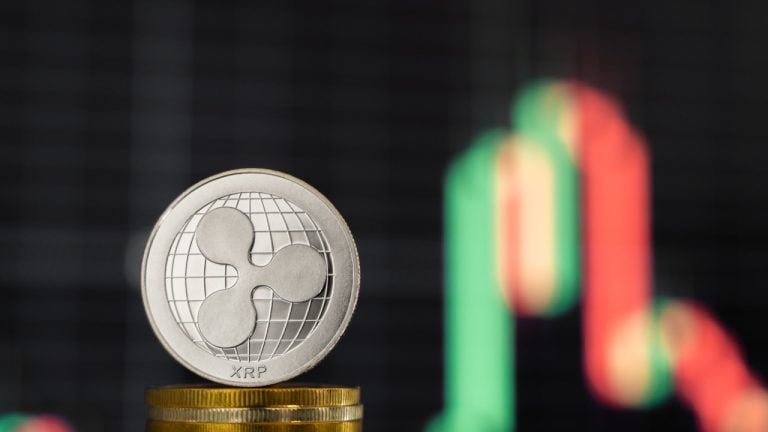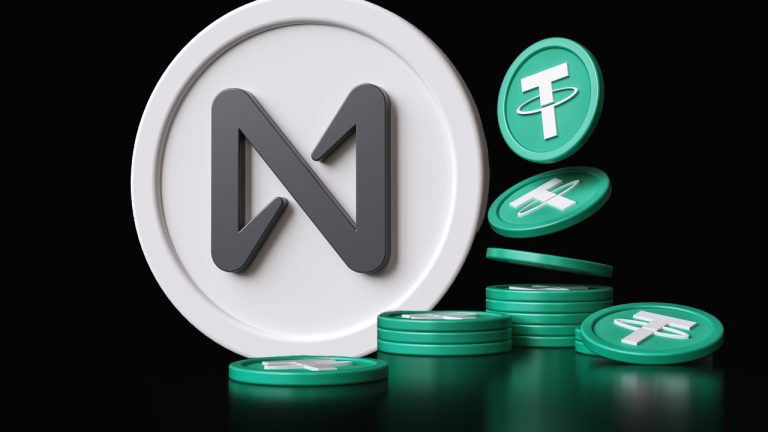 XRP moved to a fresh four-month high on Thursday, which comes as volatility in the crypto markets eased, following the latest U.S. Federal Open Market Committee meeting. The token rose past a key hurdle in today’s session, hitting its highest point since May. Algorand was another notable mover, with prices climbing by as much as […]
XRP moved to a fresh four-month high on Thursday, which comes as volatility in the crypto markets eased, following the latest U.S. Federal Open Market Committee meeting. The token rose past a key hurdle in today’s session, hitting its highest point since May. Algorand was another notable mover, with prices climbing by as much as […]
Crypto and stock markets continue to correct, but that doesn’t mean all the investment opportunities are gone.
Prices remain soft across the market as traders await Federal Reserve Chair Jerome Powell’s statement on the size of the next interest rate hike.
At the moment, the market consensus is a 0.75 bps rate hike and a sliver of analysts are banking on 1%.
Stocks also appear en-route to close the day in the red, with the Dow down 0.75%, and the S&P 500 and Nasdaq registering a 0.79% and 0.64% loss. Bitcoin continues to fight what appears to be a losing battle at the $19,000 mark, while Ether (ETH) dug a little deeper into its post-Merge dip by making an intra-day low at $1,329.
While BTC, Ether and altcoins aren’t making any notable moves that defy the current downtrend, from the perspective of market structure and technical analysis, there are a few interesting developments occurring.
Lido (LDO) has corrected alongside Ethereum now that the Merge-trade fervor has subsided, but the asset currently trades in what some would say is a bull flag. While ETH bulls and traders might have taken profits on their long Ether positions, the Merge was a success, stakers and validators still derive yield from the altcoin and the fundamentals that turned investors bullish on Ether remain present.
Ideally, if Ether's DApps and active users continue to expand and traders keep accumulating, then in an otherwise down market, yield should be a capital magnet no?

From a market structure point of view Ripple (XRP) looks interesting, and there’s been a ton of social chatter about it on Twitter lately. Following the usual hopium-laced narrative, members of the XRP army have been suggesting that if XRP beats its SEC case and is not deemed a security, the price could “moon.”
Of course, solid fundamentals and signs of growth via new address and an in-demand product to market fit should drive investments, but in the absence of that, the market structure does look interesting.

Basically, there’s pre-bull market precedent of a lengthy consolidation phase within a rounding bottom that is somewhat similar to what we can see from the last 137 days. Volumes are kicking up, price broke through a long-term descending trendline that has historically served as resistance and from the perspective of XRP’s HTF market structure, one might conclude that a price bottom has been found.
But as a word of caution, hype and expectation tend to trigger volume surges. Regardless of whether the SEC decides that XRP is a security or the opposite, investor excitement could still peter out and the price could simply trade in the same sideways range in perpetuity or until the “next bull market.”
Related: Price analysis 9/19: BTC, ETH, BNB, XRP, ADA, SOL, DOGE, DOT, MATIC, SHIB

Algorand’s (ALGO) market structure also looks interesting. Price fully retraced the complete bull market rally and now trades in the same range as it did in 2019 and 2020. Occasional buy volume pops haven’t been sustained for long enough to clear the $0.40 level, but things could get spicy if a few daily closes above this zone and a test of the 200-MA at $0.48 occurred.
If the wider market began to consolidate and ALGO buy volume sustains, flipping this moving average to support could see upside to $0.69, and daily closes above $0.80 would set a significant higher high that would indicate confirmation of a trend reversal.
As a disclaimer, these charts simply reflect assets that look “interesting.” Currently, the market is still overwhelmingly bearish and large caps like BTC and ETH have yet to find a bottom.
Ultimately, it’s the Federal Reserve that is calling the shots on what happens in risk assets like crypto. So take these snapshots with a grain of salt and proceed with caution.
The views and opinions expressed here are solely those of the author and do not necessarily reflect the views of Cointelegraph.com. Every investment and trading move involves risk, you should conduct your own research when making a decision.
 On Monday, the stablecoin issuer Tether Operations Limited announced that the stablecoin tether is now supported by the Near blockchain network. Following a number of recent implementations, Near will be the 14th blockchain network that hosts the largest stablecoin by market capitalization. Tether Connects With the Near Protocol Tether has revealed that tether (USDT) is […]
On Monday, the stablecoin issuer Tether Operations Limited announced that the stablecoin tether is now supported by the Near blockchain network. Following a number of recent implementations, Near will be the 14th blockchain network that hosts the largest stablecoin by market capitalization. Tether Connects With the Near Protocol Tether has revealed that tether (USDT) is […]
Algorand has increased its transaction speed, processing capacity and cross-chain functionality with a major upgrade.
Pure proof-of-stake (PPoS) blockchain Algorand has introduced cross-chain communication and transaction speed improvements with the latest upgrade to its protocol.
The layer-1 blockchain network announced the implementation of State Proofs to its mainnet, which introduces trustless communication between different blockchain protocols. The upgrade also increased Algorand’s processing speed from 1,200 to 6,000 transactions per second.
The upgrade also includes the provision of new tools for developers as well as on-chain randomness capabilities for decentralized applications (DApps) running on Algorand. On-chain randomness is a key feature of Algorand’s PPoS consensus, in which network validators are chosen at random despite the respective amount of staked Algorand (ALGO) tokens.
As Algorand unpacked in a recent Medium post, State Proofs are cryptographic proofs of Algorand’s state that allows DApps on other blockchains to trustlessly verify Algorand transactions. The upgrade also increased the block size to 5 MB and a “sub-4-second block latency and finality.”
The introduction of State Proofs allows Algorand to securely connect to different blockchain networks without using an intermediary. Cross-chain interoperability and connectivity have mainly been powered by cross-chain bridges and validator networks, which have been subject to high-level exploits in recent times.
3/ Today’s upgrade also features an increase in performance from 1,200 to 6,000 TPS and new best-in-class developer tools, allowing organizations building on #Algorand to continue to scale to meet growing demand for #Web3 applications pic.twitter.com/1CJyL0587L
— Algorand (@Algorand) September 7, 2022
Algorand touts its quantum-secure, trustless State Proofs as a solution to the centralized nature of storage points in existing cross-chain service providers and platforms. Exploits of cross-chain bridges have resulted in the loss of more than $2 billion in 2022 alone.
Paul Riegle, chief product officer at Algorand, highlighted the upgrade as a significant step in facilitating the growth of Web3 platforms running on its network:
“From State Proofs, which are a game-changing blockchain interoperability security feature, to increased TPS, we are unlocking the tools required for Web3 applications to fulfill their vast potential.”
Algorand’s upgrade is timely considering that Ethereum is on the cusp of its transition from proof-of-work to proof-of-stake (PoS) consensus, with the Merge set to take place in the next couple of weeks. Ethereum’s move to PoS is set to drastically improve the scalability and efficiency of the network while reducing its carbon footprint.
Algorand is the brainchild of MIT professor Silvio Micali, who founded the PPoS blockchain to address what is known as the “blockchain trilemma.” The trilemma suggests that no blockchain can be simultaneously decentralized, scalable and secure.
 The international soccer governing body, FIFA, has announced the upcoming launch of an NFT platform for fans of the sport across the globe. FIFA+ Collect will offer digital collectibles perpetuating the greatest game moments of FIFA’s world cups, the organization promised. FIFA Develops NFT Platform in Partnership With Blockchain Firm Algorand The International Federation of […]
The international soccer governing body, FIFA, has announced the upcoming launch of an NFT platform for fans of the sport across the globe. FIFA+ Collect will offer digital collectibles perpetuating the greatest game moments of FIFA’s world cups, the organization promised. FIFA Develops NFT Platform in Partnership With Blockchain Firm Algorand The International Federation of […]
Universities implement physical and virtual research hubs dedicated to advancing blockchain technology through scientific and educational knowledge.
The demand for organizations to adopt blockchain technology is growing rapidly. Recent findings from market research and advisory firm Custom Market Insights found that the global blockchain technology market size was valued at $4.8 billion in 2021, yet this amount is expected to reach $69 billion by 2030. While notable, it’s become critical for the industry to enable rigorous research into the development of the blockchain sector.
Tim Harrison, vice president of community and ecosystem at Input Output Global (IOG) — the developer arm behind the Cardano blockchain — told Cointelegraph that during the past year, the blockchain ecosystem has witnessed various risks from projects that have taken a “go fast and break things” approach.
“Not only do these companies run these risks for themselves, but mistakes and failures can also negatively impact their end consumers,” he said. As such, Harrison believes that peer-reviewed research can help prevent such situations while also resolving issues that continue to linger from earlier iterations of blockchain development.
In order to ensure that blockchain projects are thoroughly researched moving forward, Harrison noted that IOG recently funded a $4.5 million Blockchain Research Hub at Stanford University. According to Harrison, the hub’s goal is to enrich the body of scientific knowledge within the blockchain and distributed ledger industry while driving a greater focus on fundamental research.
Although the Blockchain Research Hub at Stanford was just announced on August 29, 2022, Aggelos Kiayias, chief scientist at IOG and a professor at the University of Edinburgh, told Cointelegraph that he believes the center will help the industry collectively solve current challenges.
For instance, Kiayias pointed out that IOG previously donated $500,000 to fund research for blockchain scalability with Stanford. This was an important initiative, as blockchain scalability remains one of the biggest issues hampering industry adoption. Yet, Kiayias noted that Stanford’s new Blockchain Research Hub will take this a step further since the projects being funded will come from researchers across a range of disciplines and backgrounds.
Kiayias added that research hubs associated with universities will likely add more value than typical blockchain-focused courses. “Stanford’s research hub will allow researchers to investigate the kinds of subjects that they are specifically interested in, giving them more freedom than taking a standard class,” he remarked. While many universities currently offer blockchain courses within their curriculum, research hubs funded by the industry may be the next step for universities aiming to advance the industry.
For example, Dawn Song, founder of Oasis Labs and a professor at the University of California at Berkeley, told Cointelegraph that Oasis Protocol, along with a number of other blockchain companies, has provided funding for the Berkeley Center for Responsible, Decentralized Intelligence (RDI). According to Song, RDI was founded about one year ago as a multi-disciplinary, campus-wide initiative focused on advancing the science, technology and education of decentralization.
Song explained that the research at RDI is focused on areas including blockchain scalability, security and privacy, usability and decentralized autonomous organizations (DAOs). For example, Song noted that research for zero-knowledge proofs is critical for ensuring scalability and privacy for blockchain projects.
Given this, she pointed out that RDI researchers have started working on a project called Orion, which is a new zero-knowledge argument system. Song also mentioned that RDI researchers are developing a new type of key maintenance mechanism that will ensure greater usability. The project is known as the “multi-factor key derivation function” and expands upon password-based key derivation functions with support from other popular authentication factors.
While innovative, Song added that RDI’s research is unique in the sense that the center is interdisciplinary:
“RDI contains faculty from Berkeley’s computer science department, finance and economics and the law school. RDI’s research covers many different disciplines that are more in-depth in comparison with blockchain courses. We focus on research, education and entrepreneurship, which can then help develop courses to train a new generation of students entering this industry.”
In addition to physical research facilities at universities like Stanford and Berkeley, virtual research hubs are being established. For example, Klaytn, an Asia-based layer-1 blockchain, recently committed $20 million in funding for a virtual research institute to support industry growth. Known as the “Blockchain Research Center” (BRC), this program will be run by a global consortium led by researchers from the Korea Advanced Institute of Science and Technology (KAIST) and the National University of Singapore (NUS).
Sangmin Seo, representative director of the Klaytn Foundation, told Cointelegraph that researchers from KAIST and NUS will also work closely with an international team of principal investigators from six other universities, such as UC Berkeley, Princeton University and Georgia Institute of Technology. “With BRC operating in an open-source manner, other researchers beyond these universities will be able to participate in ongoing research projects or submit their own proposals,” he remarked.
Seo shared that BRC research will span seven pillars focused on topics such as consensus, privacy, smart contacts, decentralized finance (DeFi) and the Metaverse. He added that although BRC is virtual, the program will regularly conduct community outreach efforts such as hosting conferences and workshops.
In addition, the Alogrand Foundation, which is responsible for maintaining the Algorand blockchain ecosystem, has committed $50 million in funding for a virtual research program. The Algorand Centres of Excellence (ACE) program started in August 2022 and takes a strong focus on the development of real-world blockchain solutions, along with social impact and sustainability projects.
Hugo Krawczyk, principal researcher at Algorand Foundation and head of the ACE program, told Cointelegraph that research teams are located across the globe to ensure a focus on local communities. He added that ACE researchers are tackling a number of problems associated with cryptography since this is the backbone of blockchain security:
“We are also analyzing errors in smart contracts as errors in these can lead to huge losses of money and confidence.”
While it’s noteworthy that blockchain projects are supporting the development of university-led research programs, the scope of these initiatives extend far beyond marketing tactics or research for a company’s own project. Shedding light on this, Krawczyk explained that although the Algorand Foundation is committed to developing its own ecosystem, emerging research hubs such as ACE are focused on advancing the entire blockchain industry:
“This is not just about educating developers to work on our own projects, but it’s about researching multiple projects that can help advance the blockchain sector. Even though we compete with each other, collaborating with others is beneficial for the space to mature and evolve.”
Echoing this, Harrison mentioned that although there is a lot of competition in the blockchain space, healthy competition is a vital part of any growing industry. “Especially in its early days, every player also needs to play its part in growing the space as a whole,” he remarked.
Indeed, collaboration seems to be key when it comes to these research centers. For instance, Song mentioned that Berkeley’s RDI will work closely with Stanford’s blockchain research hub. Krawczyk added that there is an ACE research center at Yale University that collaborates with Columbia University and the City College of New York.
Another important point to note is that while it’s innovative for universities to offer blockchain courses as part of their curriculum, research hubs go a step further. Steven Lupin, director of the Center for Blockchain and Digital Innovation at the University of Wyoming, told Cointelegraph that university research hubs offer distinctive, hands-on learning opportunities. He said:
“These programs allow students to roll up their sleeves and develop and deploy blockchain and digital asset projects in a real-world environment. Universities also take a leading role in developing standards and governance that’s more difficult for the industry to create due to competitive pressures.”
For instance, Lupin mentioned that the University of Wyoming Center for Blockchain and Digital Innovation — which was founded in 2019 and is focused on developing educational programs and applied projects across campus — is working on a smart contract research group to develop standards, governance and interoperability to allow smart contracts to be deployed more effectively.
While university-led blockchain research centers may be the next logical step for advancing the blockchain ecosystem, more work needs to be done to ensure that such programs are created.
“With Web3 still in its early stages, one research center alone is unable to solve all the challenges that lie ahead. More research centers are required to collectively solve such challenges,” Seo remarked. He added that research centers such as Klaytn’s BRC are multi-year projects that take time and effort to develop.

A trading robot that’s garnered a reputation for outperforming the markets is unveiling its newest portfolio allocations as most cryptocurrencies try to recover from a week-long slump. Every week the Real Vision Bot conducts surveys while compiling algorithmic portfolio assessments that generate a “hive mind” consensus. The bot’s latest data reveals that traders’ risk appetite […]
The post Trading Bot Known for Beating Crypto Markets Allocates to Solana (SOL), Cardano (ADA), and One More ETH Rival appeared first on The Daily Hodl.

A trading robot with a reputation for outperforming the markets is revealing its latest portfolio allocations as most cryptocurrencies try to recover from a weekend dip. Each week the Real Vision Bot conducts surveys while compiling algorithmic portfolio assessments to arrive at a “hive mind” consensus. The bot’s freshest data finds that traders’ risk appetite […]
The post Robot Known for Beating Crypto Markets Allocates to Ethereum (ETH), Cardano (ADA) and Additional ETH Rival appeared first on The Daily Hodl.

SkyBridge Capital founder Anthony Scaramucci tells crypto investors to avoid knee-jerk reactions as he predicts a huge price tag for Bitcoin (BTC) in the coming years. In a new interview with CNBC, the hedge fund veteran cautions investors to “see through the current environment” and resist emotion-based trading. “You’re getting better-than-expected inflation data… I was […]
The post Anthony Scaramucci Warns Against Emotional Trading, Predicts Massive Gains for Bitcoin in Coming Years appeared first on The Daily Hodl.